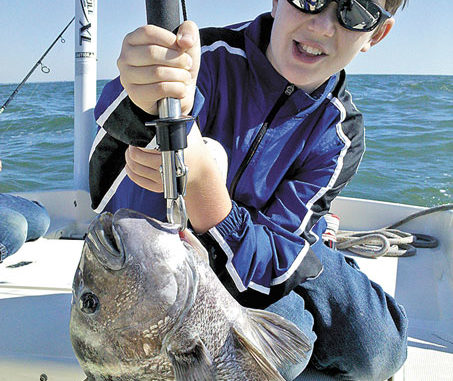
If you’re always looking for an angle to improve your chances at catching fish, then cold weather might actually be your friend. If it’s too cold to go fishing some days, everyone can still at least talk about going fishing. Fishing seminars, sponsored by tackle shops and outdoors shows, are popular during the winter because organizers know they can reel in anglers with speakers willing to share some of their knowledge.
Capt. John Ward of Affinity Charters is a guide in Charleston who is sought-after as a speaker at such seminars, and he loves to talk about winter fishing.
“Many species will move when the water temperature hits 60 degrees, which is sort of the magic-number plateau for fish to change their patterns,” said Ward (843-693-2460). “In winter, in general, I like to lighten up all my tackle to ultralight, and I spool up with 6- or 8-pound test on 2000 or 2500 series reels.’
Ward said he targets redfish and trout, but the unsung hero of winter fishing is the sheepshead. In the understatement of this young year, Ward used an analogy with a freshwater fish with a reputation for being steady all year long.
“The sheepshead is a saltwater bream on steroids,” he said.
Redfish school up tight in cold weather, and the colder it gets, the larger the schools of fish become, with hundreds on a place such as a shallow-water flat. Trout react by heading for deep holes, trying to find a more moderate water temperature, one unlikely to experience large swings downward. But during the coldest times, even if you locate these fish, you may find that they have developed lockjaw.
“If fish are in real cold water they may be so lethargic that they don’t really come over and take the bait, or if they do manage to grip it, sometimes we pull the hooks on the fish trying to get these stiff fish to the boat,” Ward said. “So I use sheepshead as a way to avoid strikeouts on charters with uncooperative weather — like the backside of a cold front, which always seems to shock the trout and bass into inaction.’
Ward’s top three baits for sheepshead are fiddler crabs, oysters and clams. “If you feel the bite of the sheepshead, then it’s too late, because your bait has been stolen,” he said.
Sheepshead have earned the nickname “convict fish” for their bait-stealing ways and black-and-white, prison-issue coloration. “Hook technology has gotten better, which helps with hook-up ratios,” said Ward, who prefers Nos. 1 or 2 mosquito hooks.
An exception would be when using the quahog — another name for small clams — for bait. “Quahogs require a small treble hook to hold the squishy meat on better, and this bait option also seems to be preferred by black drum, who can also be around the structure that the sheepshead hang on,” Ward said.
To locate sheepshead, Ward likes to look for old docks or old structures that have barnacle growth. Rip-rap walls, or possibly where a tree fell along a bank a year earlier or so, can also be productive, and Ward prefers to fish these areas on the lower end of the tide cycle. Sheepshead are known to be on nearshore artificial reefs and around rock jetties during winter, but Ward has also caught them five miles up the Ashley and Cooper rivers.
A student of Charleston history, Ward even knows the location of piles of old ballast stones that can hold sheepshead.
Look for a dock in the bend of a river where the current has gouged out a hole underneath some cover. Anchor up the best you can in order to fish vertically, because that allows an angler to feel the bite better. A location that holds at least five feet of water at low tide is a prime spot, according to Ward. Braided line works well for sheepshead, because it does not have the stretch of monofilament, and that keeps sensitivity at a premium.
Ward uses a short leader, eight to 10 inches, to deal with abrasion from the structure, and of course, to combat the horse-like teeth of the sheepshead.
“Drop the bait down until you feel the weight hit the bottom, and then pick it up just a bit, and then hold on,” Ward said. “With the gin-clear water clarity, you can sometimes see the sheepshead coming to eat your bait.’ Once hooked, the sheepshead offers a great fight, but once away from the structure, they can usually be landed.”
Getting a pint or two of fiddlers is easy; many tackle shops carry them. Before you know it, you can be on the water fishing.
Isn’t it funny how sometimes talking about fishing is actually the best way to get fired up enough to grab the rods and go fishing, even if a winter jacket is part of your tackle for the day.



Be the first to comment